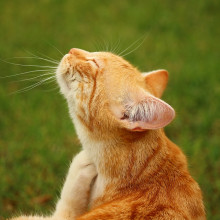What's going on when you reach out to pet a cat? How do you learn it's fuzzy? Léa Wenger fills us in...
In this episode

Naked Body: Our sense of touch
Lea Wegner
What's going on when you reach out to pet a cat? How do you learn it's fuzzy? Lea Wegner fills us in...
When I stroke a cat, I am aware of the softness of its fur, I can feel the ridges of its spine (unless it’s very fat cat) and I know in which direction the fur is moving, with respect to my hand. This is all information that I can obtain through my touch. Voluntary movement is key to the lives of most of us, and touch is a key in guiding our movements. But how does our skin relay the information? How has the pressure applied on this cat’s back been interpreted in my brain?
Like most of your senses, touch works through a sensory pathway that consists of an external stimulus, in this case the cat’s fur, detected by a receptor in your skin, transmitted through nerve cells to the brain where the information will be broken down and analysed. Cat petting is serious biological business.
The stimulus is perceived by a sensory neuron with a long, thin process called an axon which extends into the skin. The sensory stimulus leads to the neuron firing, and the resulting change in the electric flow within it codes for the information and sends it to the brain. Depending on the frequency of this firing and how it interacts with other incoming signals, the sensation will be interpreted in different ways.
But how do I know I am stroking the cat and not the carpet next to it? What causes specific neurons to become activated?
When force is applied to a nerve fibre, the tip of the nerve fibre, the bit within your skin, deforms with the force applied. This makes special channels open, which changes the electric flow, activating the neuron.
Neurons tend to be selective with the signal they respond to. What type of touch information is detected (whether it’s pressure, tension, stretch, ‘stickiness’, etc.) depends on what structures are surrounding the nerve ending in the skin.
Some of these accessory structures resemble elastic, onion-like cushions: these are called Pacinian corpuscles. Because of the elasticity of the capsule, the shape of the cushion after applying pressure is restored rapidly. So the associated nerve endings detect changes and respond well to vibration.
They are the receptors in my fingers that would detect whether the cat is purring when I stroke it, even if I could not hear the purring.
Other receptors signal skin tension and are particularly sensitive to edges. They probably tell you when you feel the spine as you stroke the cat along its back. The higher the density of receptors in an area, the better the tactile acuity, as in hands, in contrast to our back. Please note the Naked Scientists do not advocate using your back to pet a cat.
So I can detect different elements of the cat’s back using different neurons and receptors. But how does the body know how to put them all together?
The information sent by neurons is ferried up via the spinal cord to the brain, where it is processed in the thalamus and a specific part of our cortex: the somatosensory cortex.
In that special area of the brain, the entire body is mapped out such that specific areas of this cortex correspond to particular regions of the body surface. So in our case we know the cat is at the end of my fingertips because the ‘fingers’ part of my cortex is activated.
So I know my fingers are feeling the fur because the pattern of the neurons which are active in my cortex depends on what kind of thing I’m touching.
When you touch something, each feature of the touch is broken down and analysed separately.
The brain then puts it all together: Am I moving? Do I need to pay particular attention to this information? Have I accurately sensed what is going on? Why is the cat biting me now?










Comments
Add a comment